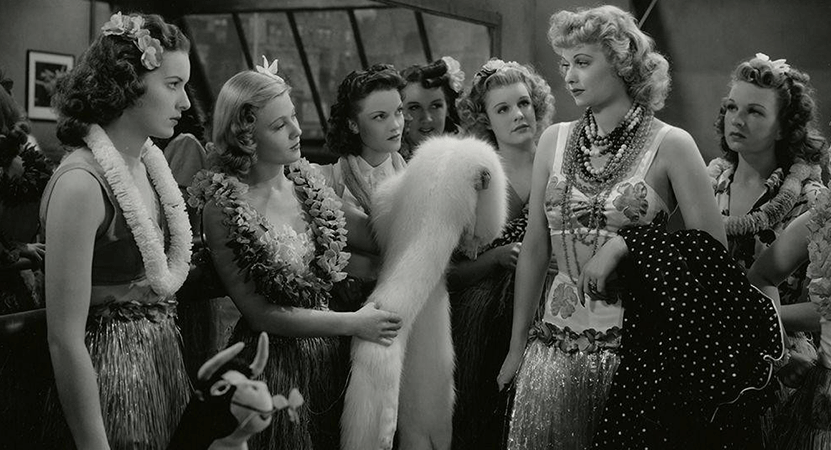RKO’s Dance, Girl, Dance was remarkable as a vehicle for two emerging stars, Maureen O’Hara and Lucille Ball, that stealthily radicalised its backstage setting and tried to slap moviegoers out of their comfort zone – probably the reason it failed commercially on release in August 1940.
The fifteenth and penultimate feature directed by Dorothy Arzner, Hollywood’s only female director of the 1930s and 1940s, turned a routine comic melodrama about rival hoofers into a vexed appraisal of the compromises faced by women performers striving for success, whether financially or creatively, in the toxic environment of New York showbiz.
Though the picture is entirely in keeping with Arzner’s career-long analysis of women’s place in modern society, she benefitted from a bristling screenplay adapted from a Vicki Baum story by wife-and-husband screenwriters Tess Slesinger and Frank Davis. The worldly leftist intellectual Slesinger (1905-1945), who co-wrote Arzner’s Joan Crawford comedy The Bride Wore Red (1937) and inscribed her experience of abortion in her only novel The Unpossessed (1934), is an author ripe for rediscovery.
 After their nightclub gig in Akron ends with a police raid, Judy O’Brien (O’Hara), Bubbles (Ball), and their six fellow chorines return to New York and the classes taught by onetime Russian Imperial Ballet dancer Madame Lydia Basilova (Maria Ouspenskaya), whom Arzner costumed in her own severely mannish attire.
After their nightclub gig in Akron ends with a police raid, Judy O’Brien (O’Hara), Bubbles (Ball), and their six fellow chorines return to New York and the classes taught by onetime Russian Imperial Ballet dancer Madame Lydia Basilova (Maria Ouspenskaya), whom Arzner costumed in her own severely mannish attire.
The sleazy promoter – his kind bedeck the movie – who comes to check out the unemployed dancers in Madame’s tenement studio picks the cheerfully lubricious Bubbles over the demure Judy to work at a burlesque show. She's soon a high-living media star patronised by salivatiing bozos and slumming socialites.
After shy Judy passes up the chance to meet with an affable Balanchine-like impresario (Ralph Bellamy), Bubbles hires her as the ballet-dancing stooge who whets her ribald audiences’ appetite for her raunchy act. The romantic subplot that starts in Akron and entangles both girls with a boozing playboy (Louis Hayward in a role Hugh Grant would have died for) and the estranged wife (Virginia Field) he still loves, is essentially filler in a film building to a scene that shames men for their crude sexual objectification of women entertainers.
Dance Girl Dance is practically a feminist dialectic. Idealistic Judy seeks fulfilment as a ballerina and true love. Bubbles seeks the highest wage she can get and has no qualms about cheapening her trade and marrying for wealth. If the RKO brass and 1940’s viewers thought Judy was the heroine and Bubbles the villain, Arzner undercut that assumption.
A true post-Depression survivor, Bubbles is clearly the more independent of the two women – Ball is sensational – which is why Arzner doesn’t punish her, suggests critic B. Ruby Rich in the video essay she contributes to Criterion’s homevideo release. For all her artistic and emotional integrity, Judy is the one who’s likely to sacrifice her career to a husband’s needs. The film’s final image is ambiguous – a comforting embrace with a chilling hint of proprietariness.
Arzner taught advance cinema at UCLA’s film school from 1961 to 1965. One of her students was Francis Ford Coppola, who – in another video supplement on the disc – recalls her giving camera tips, bringing cookies to their long classes, and telling him he would make it as a director at a moment when he considered quitting. Coppola later found a uniquely personal way of honouring her.














Add comment